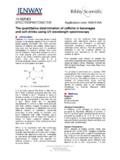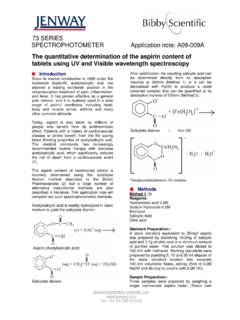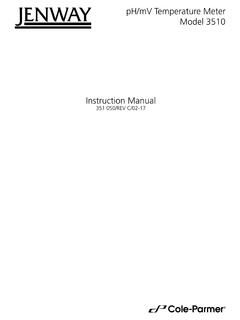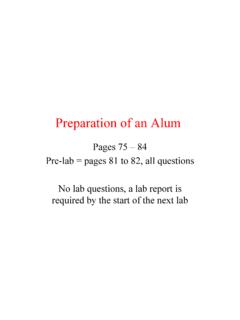Transcription of A09-013A Troubleshooting Guide for Nucleic Acid …
1 Tel: +44 (0)1785 810433 Genova Plus/Nano Application Note: A09-013A Troubleshooting Guide for Low and Micro Volume Measurements of Nucleic Acids with the Genova Plus/Nano Introduction The quantification of Nucleic acids is a necessary procedure to allow the analyst to plan downstream applications, such as PCR, RT-PCR, sequencing, restriction digestions and ligations efficiently. Micro-volume quantification allows for the rapid assessment of the concentration and purity of Nucleic acid samples using minimal amounts of valuable samples, but the analyst must be aware that as sample volume decreases, the risk of sample preparation and instrumental measurement errors increases.
2 This application note introduces the Genova Plus/Nano s multi-wavelength measurement mode, details some of the potential sources of error in semi-micro and micro volume measurements and provides some practical techniques that the analyst can employ to minimise these potential errors. Display Information The 260/280 method that can be selected from the DNA measurement mode in the Life Science menu allows users to calculate the concentration of Nucleic acids according to the commonly used equation:- Conc ( g/ml) = (Abs@260nm x ) - (Abs@280nm x ) An option to subtract the absorbance value at a reference wavelength is available After the completion of a measurement the display will show Pressing the button next to the calculator icon displays the photometric data and the method s calculations.
3 Concentration Ratio A260/A230 > Ratio A260/A280 Calculator Icon A260 (optimal ) Aref (ca. ) A230 A280 Tel: +44 (0)1785 810433 A260 nm Absorbance maximum of Nucleic acids The optimal absorbance range for the accurate measurement of Nucleic acids is between and Abs. When using a 1cm path length cuvette in the Genova Plus this absorbance range equates to concentrations of dsDNA of g/ml to 50 g/ml. In the Genova Nano the equivalent dsDNA concentrations are 50 g/ml to 1000 g/ml @ path length and 125 g/ml to 2500 g/ml @ path length.
4 Is the absorbance value between and @260nm? When the measured absorbance values are low (< ) the contribution of instrument and sample preparation errors becomes too significant for accurate measurements to be made. A280 nm Absorbance maximum of proteins and phenol 280nm is the reference wavelength that is used when determining the purity of Nucleic acid samples. Ratio A260/A280 The ratio of the absorbance values at 260nm and 280nm for pure DNA is and for pure RNA is Lower values indicate that the sample is contaminated by proteins containing aromatic groups and/or phenol.
5 Is the value approximately for DNA and approximately for RNA? A230 nm Absorbance maximum of carbohydrates 230nm is a second reference wavelength that is used when determining the purity of Nucleic acid samples. Ratio A260/A230 The ratio of the absorbance values at 260nm and 230nm for pure DNA and RNA should be greater than Lower values indicate that the sample is contaminated by sugar, salts or organic solvents. NO Dilute or concentrate sample YES No corrections required NO Indicates that the sample may be contaminated by proteins or phenol. Purify the sample.
6 YES Indicates that the sample is pure Tel: +44 (0)1785 810433 Is the value greater than A320 nm Measured to take account of turbidity in the sample solution An absorbance measurement is taken at 320nm to correct for any turbidity in the solution when determining the concentration and purity of Nucleic acid samples. Is the value approximately Nucleic acid and Protein Absorbance Spectra Typical absorbance spectra of pure Nucleic acid and protein samples are shown in Figure 1. Figure 1 NO Indicates that the sample may be contaminated by carbohydrates, salts or organic solvents.
7 Purify the sample. YES Indicates that the sample is pure NO Indicates that particulate matter is present in the sample. Purify the sample or ensure that A320 correction is enabled YES Indicates that the sample is free from particulate matter. A320 correction is not required Tel: +44 (0)1785 810433 Frequent Sources of Errors Sample Preparation Dilution errors Dilute the sample in the ratio 1:10 to 1:50 as greater ratios can lead to pipetting errors. Pipettes Check that the pipettes being used are clean, calibrated and functioning correctly. Sample mixing All Nucleic acid samples should be vortexed prior to dilution and measurement to eliminate any concentration gradients in the sample.
8 Sample pH The absorbance spectrum of Nucleic acids is influenced by the pH value of the sample solvent, especially in solutions with low ionic strength. Use 10mM Tris-HCl pH or TE pH to buffer the sample. Cuvette considerations Quartz or special UV grade plastic cuvettes must be used for all Nucleic acid sample measurements. When using micro-volume plastic cuvettes, ensure that the instrument is fitted with the micro cuvette holder accessory, part code 637 071. Plastic cuvettes should not be reused too often as UV light can degrade the plastic.
9 The recommend fill volume of the cuvette must be considered to eliminate any effect from the sample meniscus and stray light. Air bubbles or other visible contaminations must be avoided. Instrument Check Incorrect factor Check that the correct multiplication factor/s have been entered into the instrument settings. Calibration Filter/ Solution Perform a measurement using a certified calibration solution. Check Re-calibrate the micro-volume accessory using the procedure described in the Genova Nano operating manual Technical Support Further technical or application support with your Nucleic acid measurements can be obtained by contacting us on +44 (0) 1785 810433 or emailing us at










